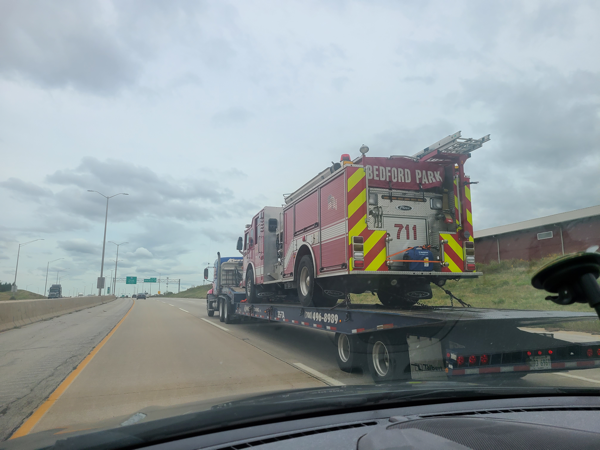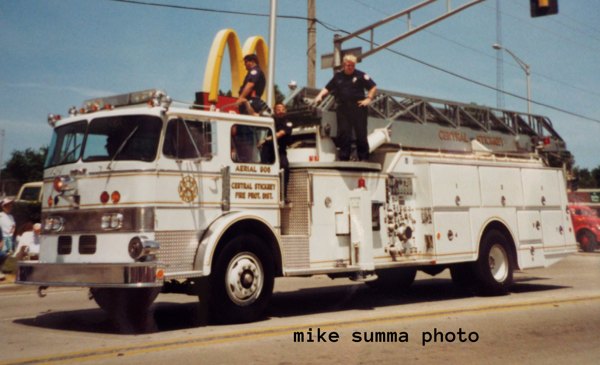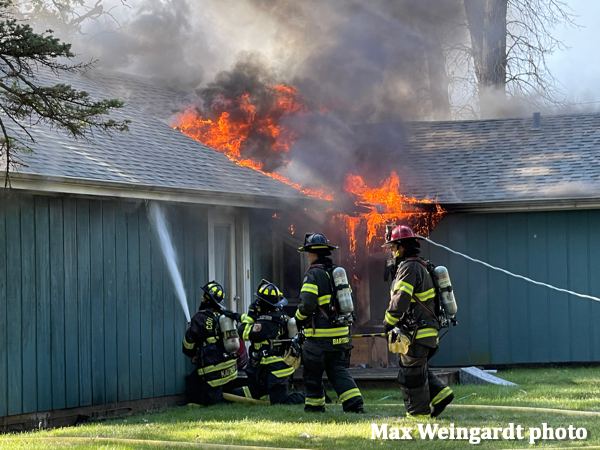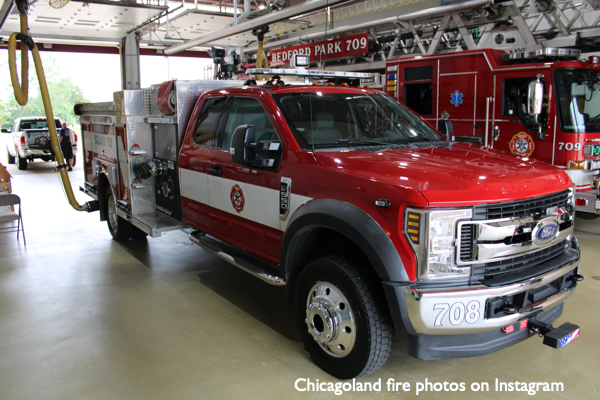From Firetruckmall.com:
2017 Ford F-550 Commercial 4×4 Rescue– Sold and DeliveredSold to Seminole County Fire Rescue – GA
thanks Martin
Sep 24
Posted by Admin in Fire Department News, fire engine for sale | Comments off
From Firetruckmall.com:
2017 Ford F-550 Commercial 4×4 Rescue– Sold and DeliveredSold to Seminole County Fire Rescue – GA
thanks Martin
Tags: 2017 Ford F550 MCB rescue truck for sale, chicagoareafire.com, Chicagoareafire.com/blog, Maintainer Custom Bodies, MCB Fire Truck, Rolling Meadows FD 2017 Ford F550 4-dr - Maintainer Custom Bodies rescue truck for sale, Rolling Meadows Fire Department, Rolling Meadows Rescue For Sale, small rescue truck for sale
Sep 23
Posted by Admin in Collectors of fire memorabilia | Comments off
This from Martin Nowak:
I saw Bedford Park Engine 711 on the back of a truck heading northbound 355 at Archer Ave. The truck continued over I-55. I’m assuming it’s heading to Pierce.

Martin Nowak photo

Martin Nowak photo
Tags: Bedford Park FD Engine 711, Bedford Park FD Engine 711 on a lowboy trailer, Bedford Park Fire Department
Sep 23
Posted by Admin in Fire Department History, Historic fire apparatus, throwbackthursday | 3 Comments
This from Mike Summa for #TBT:
For TBT-This is the Central Stickney FPD’s Truck 906, a 1960’s Duplex/Howe/Grove 1250/0/85′.Mike Summa

Mike Summa photo
Tags: #TBT, Central Stickney Fire Protection District history, Central Stickney FPD vintage Duplex-Howe-Grumman aerial ladder, Duplex Howe Grove aerial, Mike Summa, throw back thursday, throwbackthursday
Sep 22
Posted by Admin in Fire Department History | 3 Comments
From Phil Stenholm:
Another installment about History of Evanston Fire Department
THE GREAT DEPRESSION
In 1930, the civil service positions of Engineer and Assistant Engineer were consolidated with the position of Fireman I, although any firefighter driving a truck or working as a tillerman had to pass a test and be certified as a driver, and any firefighter working as a motor driver on an engine company had to pass a test and be certified both as a driver and as a pump operator.
Three veteran firemen – Frank Altenberg, Max Kraatz, and William Richards — were certified as steam pump engineers, and they were the only members of the EFD who were allowed to maintain, repair, and operate the tractorized-steamer kept in reserve at Station # 4. Among Evanston firemen who were not officers, only the two fire equipment mechanics – J. K. “Karl” Wilen and Norman “Foxy” Fochs, who were assigned as motor drivers on opposite platoons of Engine Co. 5 — remained separate and distinct (and more highly-paid).
From 1928 through 1932, the aggregate maximum daily shift staffing for EFD companies was 41, with an aggregate minimum daily shift staffing of 34 if each company was running one-man short. Firefighters were allowed two weeks’ paid vacation each year, but vacations were not permitted from November to March.Other than the annual two-weeks paid vacation, firemen were not paid for hours not worked, and that included absences due to illness, jury duty, a death in the family, even a temporary disability resulting from an injury incurred in the line of duty. If the absence of a company member caused the company to run more than one man short on a particular shift, one of the men assigned to the opposite platoon of that company would be required to remain on duty and work his day off, and then he would receive a “comp day off” at a later time, to be determined by the company officer when the company was back at full-strength.
Annual EFD salaries ranged from $4,800 (Chief Fire Marshal) to $3,300 (1st Assistant Chief Fire Marshal) to $3,000 (2nd Assistant Chief Fire Marshal) to $2,880 (Captain) to $2,700 (Lieutenant) to $2,640 (Fire Equipment Mechanic) to $2,400 (Fireman I) to $2,280 (Fireman II) to $1,920 (Fireman III).
However, as the “Great Depression” tightened its grip on the country, City of Evanston employees went unpaid over the last two weeks of December 1932. The mayor ordered staffing and pay cuts in all city departments effective January 1, 1933, and as a result, six positions were “axed” from the EFD at that time.
Because only three of the six positions could be eliminated through attrition — 1st Assistant Chief Ed Johnson (a platoon commander and the company officer of Truck Co. 1) suffered a fatal heart attack at the end of shift on October 22nd, and Capt, George Hargreaves (company officer of Engine Co. 1) and Fireman George Gushwa retired on December 31st — the three firemen with the least seniority (Philip Line, Lincoln Dickinson, and John Kabel) were laid-off. All three men returned to the EFD within two or three years, however, after Capt. Pat Gaynor (Engine Co. 4) retired in 1934 and firemen John Gaynor, John Tesnow, and Henry Thoms retired in 1936. For John Kabel, the last three months of 1932 was an especially painful time. Besides losing his job, he also suffered a gunshot wound while duck hunting in October!
At the time that they retired, George Hargreaves and George Gushwa were the longest-serving members of the Evanston Fire Department, with Hargreaves having set the all-time record for longest tenure with the EFD up until that point in time with 38 years of service, a mark that would not be exceeded until the 1940’s. Hargreaves joined the EFD in 1894, was promoted to lieutenant in 1902, and then to captain in 1903, while Gushwa joined the EFD in 1901.
The staffing cuts of January 1, 1933, caused Engine Co. 1, Truck Co. 2, and Engine Co. 2 to be reduced by one man each shift, resulting in a new maximum daily aggregate shift staffing of 38 if no firemen were absent. The minimum daily aggregate shift staffing permitted was dropped from 34 to 31, which could happen only if all seven companies were running one man short. Engine Co. 5 and Truck Co. 1 – the companies first-due to downtown Evanston’s high-value district –- still required a five-man minimum staffing each shift, but the other five companies now required a minimum staffing of only four-men per shift. Shift staffing would not return to the pre-1933 level ever again.
Salaries were cut by 7.5% in 1933, with an even greater reduction the following year, for a total cut covering both years of 20 – 25%! 1934 annual EFD salaries ranged from $3,900 (Chief Fire Marshal) to $2,553.60 (Assistant Chief Fire Marshal) to $2,228.64 (Captain) to $2,089.44 (Lieutenant) to $1,920 (Fireman). EFD salaries began to increase slightly in 1937, but pre-Depression salaries would not be seen again until 1944. Meanwhile, Evanston’s population in 1933 stood at 61,754, up more than 40% over the city’s population in 1923.
In addition to the cuts in the Evanston Fire Department on January 1, 1933, the Chicago Fire Insurance Patrol closed two of its eight firehouses on that same date. Included in the CFIP’s cuts was Patrol No. 8, located at 3921 N. Ravenswood Avenue. Since being placed into service in 1922, Patrol No. 8 had responded to fires in Evanston’s downtown “high-value district,” the Main Street and Central Street business districts, the Northwestern University campus, hospitals, schools, hotels, apartment buildings, factories, and high-value residential properties.
Patrol No. 8 was located six miles from Evanston’s downtown high-value district and could arrive anywhere in Evanston within 15 minutes of being dispatched from its quarters on Ravenswood Avenue, but with the closing of Patrol No. 8’s house, the nearest CFIP firehouse was now ten miles away. So for that reason, along with the City of Evanston’s budget cuts taking effect on January 1, 1933, Evanston’s contract with the Chicago Fire Insurance Patrol was terminated effective on New Year’s Day.
Tags: Chicago Fire Department history, chicagoareafire.com, Chicagoareafire.com/blog, Evanston FD Captain George Hargreaves, Evanston Fire Department history, History of Evanston Fire Department, Phil Stenholm
From Chicagoland fire photos on Instagram:
a visit to CFD Engine 60
home to-Engine 60tower 37battalion 5ambo 38

Chicagoland fire photos on Instagram
Tags: Chicago FD Battalion 5, Chicago FD Engine 60, Chicago FD Engine 60's house, Chicago FD Tower Ladder 37, Chicago Fire Department, Chicago firehouse, Chicagoland_fire_photos, Inside Chicago FD Engine 60's house
Sep 21
Posted by Admin in Fire Department News | 19 Comments
Excerpts from Fox32chicago.com:
Leaders in Clarendon Hills are looking to share a fire department ladder truck with another community, saving a big chunk of change.
One village official says that public safety comes first, but if they can get by with sharing a ladder truck with a neighboring community, then why not save that money?
Some community members are upset at the thought that the Clarendon Hills Fire Department wouldn’t have its own ladder truck, fearing response times would be longer. They have organized, and there is a Change.org petition as well as yard signs being put up.
The issue at hand is the current ladder truck is getting old and needs to be replaced. The cost is well over a million dollars. The village manager says they are still researching their options to replace it or rely on another department when they need the ladder truck.
There is a village board meeting Monday night. The ladder is not on the agenda, but they are expecting some public comment. The village manager says they have a lot more to research before they make a decision.
thanks Scott
Tags: chicagoareafire.com, Chicagoareafire.com/blog, Clarendon Hills FD new ladder truck confusion, Clarendon Hills FD new ladder truck discussion, Clarendon Hills Fire Department
Sep 20
Posted by Admin in Fire Department News | 1 Comment
Excerpts from Fox32chicago.com:
A fire ripped through St. Paul Lutheran Church in suburban Beecher on Sunday, and the building is believed to be a total loss.
Firefighters had actually been called to the building to help an ill patient, when someone noticed the flames.
The congregation was holding their annual Oktoberfest in the parking lot when the fire started.
One firefighter was hospitalized for heat exhaustion, and three others were treated on the scene.
The church was built in 1865 and served as a set for the 2013 Tom Hanks-Jude Law film “Road to Perdition.”
Tags: Church destroyed by fire in Beecher, St. Paul Lutheran Church in Beecher destroyed by fire
Sep 20
Posted by Admin in Apparatus on-scene, Fire Scene photos | Comments off
This from Max Weingardt:
Countryside fire protection district Second a Alarm 26236 Maple Ave 9/18/21

Max Weingardt photo
Tags: 2-Alarm fire in Mundelein, Countryside Fire Protection District, Countryside FPD Engine 412, fire scene photos, firefighters battle house fire, house fire in Mundelein, Max Weingardt, Mundelein FD quint at fire scene
From Chicagoland fire photos on Instagram:
Bedford park station 3 visit
Home to-
Tower 709Squad 708

Chicagoland fire photos on Instagram
Tags: Bedford Park FD Squad 708, Bedford Park FD Station 3, Bedford Park FD Tower 709, Bedford Park Fire Department, Chicagoland_fire_photos on instagram, Pierce Dash CF PUC tower ladder, Rosenbauer mini-pumper
You are currently browsing the archives for September, 2021

For the finest department portraits and composites contact Tim Olk or Larry Shapiro.
Arclite theme by digitalnature | powered by WordPress